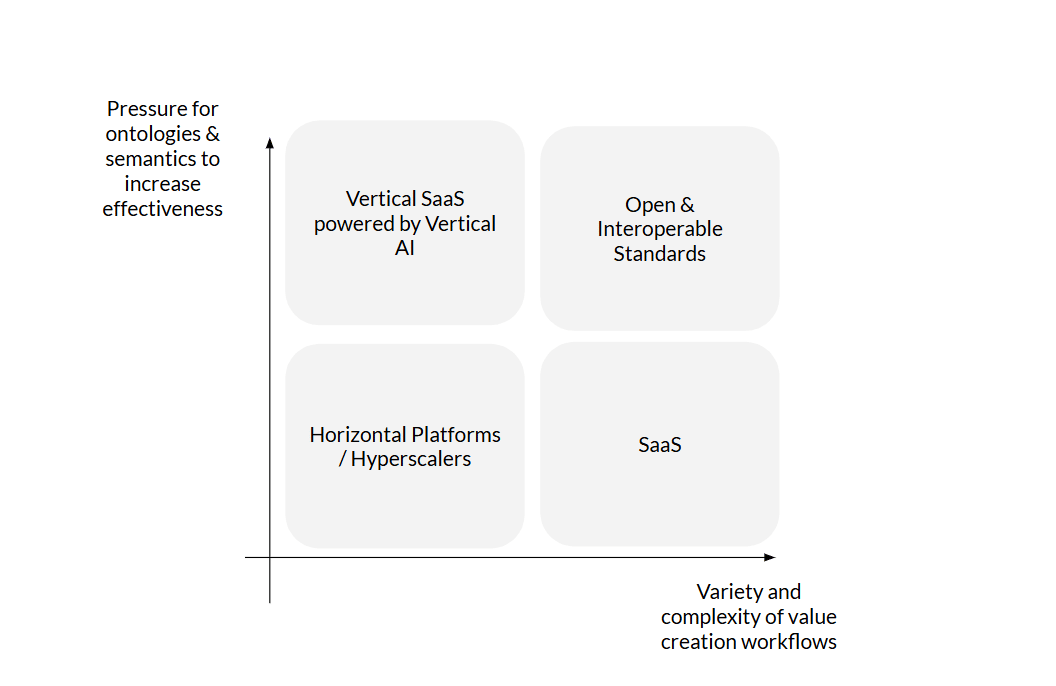Why Workflow and Organization Modeling is the Key to AI Success
In today’s AI-driven landscape, competitive advantage no longer lies in access to technology or intelligence. The real differentiator is semantic: organizations that can effectively model their workflows and create interoperable systems will lead the AI revolution. Learn why shared ontologies and workflow modeling are becoming the new strategic imperatives for business success.
Simone Cicero
Something is becoming increasingly evident: access to technology or intelligence no longer defines the edge. In the age of widespread AI, the real challenge to reap the benefits of AI adoption is semantic, and competitive advantage will come from the ability to model work explicitly and in interoperable ways.
The message in the great piece from Alexander Doria “The Model is the Product” is extremely clear: value is shifting from pure inference to the capability to create vertical applications of general models that enable a particular workflow, with evidence starting to form around Deep Research or coding use cases.
In a few words, representing the tasks, and all the operational entities involved in a particular workflows, affects the capability to use AI to generate better outcome results.
It appears that computational power and generative intelligence can become commoditized, and what remains valuable is a structured understanding of what needs to be done, by whom, how, and why.
This resonates deeply with another piece from Matt Brown on AI wrappers and vertical software curated today where he highlights how vertical AI models are under pressure from two sides: on one hand, increasingly capable (and cheap) generalist AI, and on the other, vertical SaaS platforms (vSaaS) that already hold the system of record and the semantics of their industries. Brown envisions a potential winning strategy in embedding what he calls “vertical AI” into Vertical SaaS solutions in a way that is “different than simply embedding AI” ad it “involves configuring AI to help vertical-specific workflows”.
But can we imagine a future where organizations must manage hundreds of vertical AI models / vSaaS for each vertical task?
On the other hand, can we imagine a context where organizations have to “sacrifice” the effectiveness of enhancing a model for vertical applications just because it’s hard to share a system of record, an ontology, and common data sources across them?
This question is essential: if the value lies in workflow modeling (which is complex and expensive to maintain), organizations can’t operate with many disjointed, closed vertical environments. This creates a structural tension: on one hand the explosion of vertical, AI-powered execution environments, while – on the other – a need to reduce ontological complexity, ensuring that interoperability is sustainable for the organizations across internal teams, units, and support structures but also with partners across the ecosystem as the capability to create value extends increasingly beyond the organization in ecosystems of partnering.
This leads to a second key implication: pressure will mount to converge on shared ontologies. If we can’t sustain infinite divergent vertical models, we must establish common metasemantics—shared standards, open specifications, and operational “languages” for agent-mediated ecosystems.

In another recent relevant piece Choudary’s AI & the Strategic Value of Hype, he highlights that – in a world of failing defensibilities – the actual ground to build defensible advantage may be speed, hype, trust, and value creation.
Value no longer resides in who owns the data or algorithms but in who maintains and orchestrates shared semantic spaces trusted, win-win, and intelligible by partners and agents.
But this raises a new question: if value accrues in the metasemantics that allow organizations to reap benefits across extended workflow models and production chains – yet, we’re incentivized to keep and govern them to be open to avoid overcomplexyfying, where can competitive advantage still come from?
It’s a new and challenging tension: the metasemantic layer must remain accessible to function, but whoever maintains it—and steers it—can play a key strategic role, technically, culturally, and even institutionally, as described in Choudary’s piece.
In his insightful piece Matt Brown also states:
“What becomes more valuable if intelligence and interactions are cheaper? It’s the data model for a vertical, the data for a specific business that fits its vertical data model, and the workflows and controls necessary to use that data to fit that specific business or industry. Or—put another way—a system of record.”
So we reiterate a consideration: when conversational potential explodes (outside but most importantly “inside” an organization), shared ontologies that describe what an organization is, what it’s trying to achieve, and how all the pieces come together and communicate are the only way to find meaning, control, security, and true intelligence and ensure we keep AI-powered systems observable, interpretable, steerable, and strategic.
Understanding your production processes and mapping the organization and communication paths onto them becomes a crucial advantage for organizations.
This perspective leads us back to our work at Boundaryless, where we help organizations build their semantic and operational models, starting from ecosystem dynamics and customer needs. Tools like the Portfolio Map Canvas were designed precisely for this: to read patterns in the organizational context, map relationships across domains and actors, and define an organizational architecture capable of exposing coherent interfaces—for agents, APIs, and human collaborators.
As an organization, you are what you understand you are, and you produce what you communicate: “The organization emerges in communication,” some used to say.
It’s a fascinating moment. And this is just the beginning.